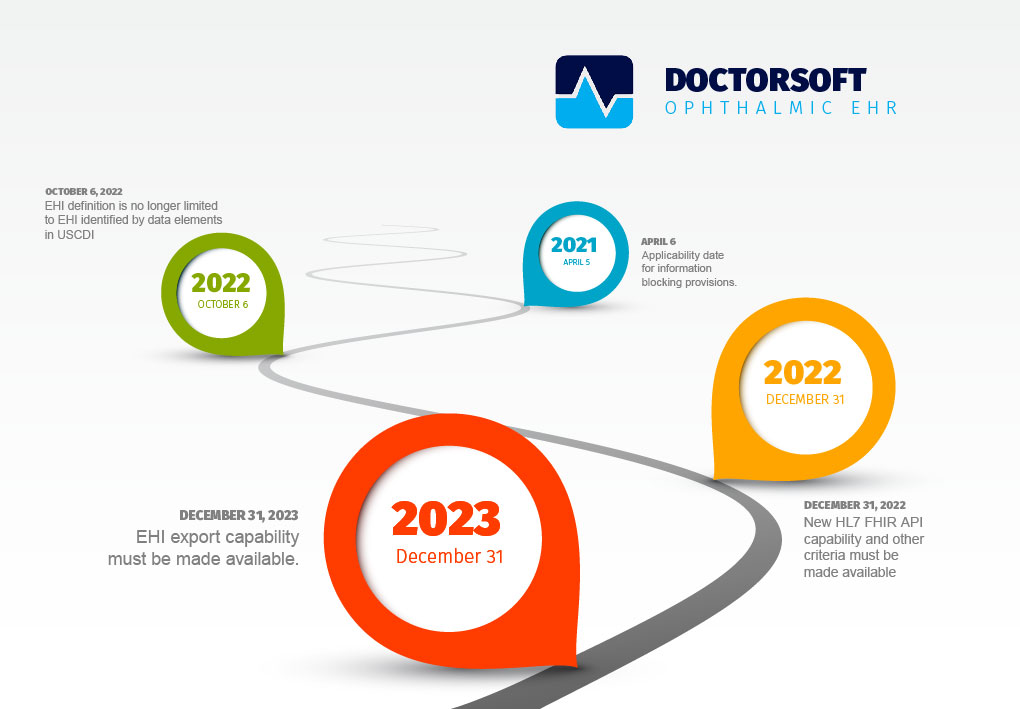
Image: 21st Century Cures Act Timeline
The information blocking rule of the federal 21st Century Cures Act dictates that eight categories of clinical notes created in an electronic health record (EHR) must be made available to patients through a secure online portal. Providers or practices may not block or delay patients’ access to any eligible information.
According to the ONC’s Cures Act Final Rule, the goal is to call on the healthcare industry to “adopt standardized application programming interfaces (APIs), which will help allow individuals to securely and easily access structured electronic health information using smartphone applications.”
As of April 5, 2021, the following eight categories of clinical notes in an EHR must be immediately available to patients:
- Consultation
- Discharge summary
- History and physical examination notes
- Imaging narratives
- Lab report narratives
- Pathology report
- Procedure notes
- Progress notes
Cures Act and Data Blocking
The Cures Act has provisions for Data Blocking rules which can impact the practices and providers.
Now, what is data blocking?
According to the Office of the National Coordinator for Health Information Technology (ONC):
“In general, information blocking is a practice by a health IT developer of certified health IT, health information network, health information exchange, or health care provider that, except as required by law or specified by the Secretary of Health and Human Services (HHS) as a reasonable and necessary activity, is likely to interfere with access, exchange, or use of electronic health information (EHI).”
Blocking provisions impede patients’ access to their EHI. Information blocking can occur in a variety of scenarios. In general, it refers to practices that are likely to interfere with the access, exchange, or use of EHI.
The ONC defines information blocking and provides eight categories of “reasonable and necessary” activities that do not constitute information blocking, given certain conditions are met. These are called information-blocking exceptions.
- Preventing harm
- Privacy
- Security
- Infeasibility
- Health IT performance
- Content and manner
- Fees
- Licensing
What does the Cures Act mean for practices?
Information blocking applies to providers, payers, and health IT developers/EHR. With a general idea of Cures Act requirements, you can ensure your practice complies. Prepare the team to respond to requests for health information from patients under the new requirements.
The Cures Act focuses on the data stored in your EHR software or other electronic forms. If a patient asks for their data, there are several options available:
- Printing the data from the EHR
- Exporting it through a Continuity of Care Document (CCD) in the EHR
- Directing patients to view and download data using a patient portal
The first step in information sharing is providing U.S. Core Data for Interoperability (USCDI) formatted data. USCDI is a standardized set of health data and elements for interoperability. A patient portal is a critical component of providing information to patients. Patients can receive USCDI data directly in the portal and share that information with other providers through email. Or, they can send it to themselves or their health proxies.
Timeline Summary of 21st Century Cures Act Milestones Through 2023:
- April 5, 2021: Applicability date for information blocking provisions.
- October 6, 2022: EHI definition is no longer limited to EHI identified by data elements in USCDI
- December 31, 2022: New HL7 FHIR API capability and other criteria must be available.
- December 31, 2023: EHI export capability must be made available
Refer to a detailed timeline of regulatory dates through 2023.
If you have any questions regarding the CURES Act in transmitting patient information? Please feel free to reach out to Doctorsoft. It is important to note that Doctorsoft Ophthalmic EHR will be fully compliant with the 21st Cures Act well before the deadline imposed by the regulatory authorities.
